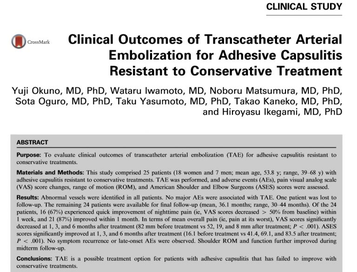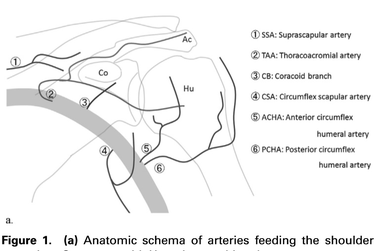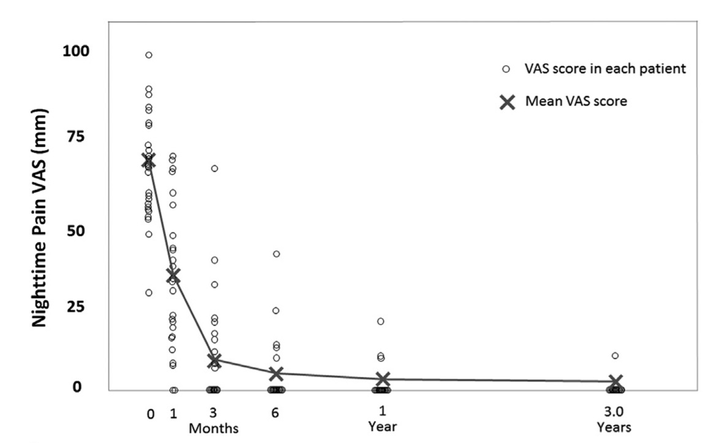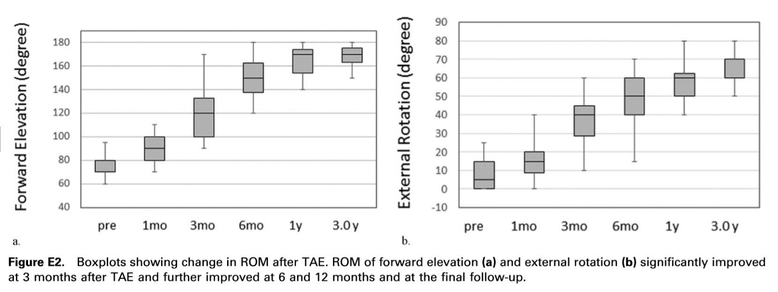Three years progress after transcatheter embolization for stiff shoulder
Published: April 27th, 2017
Title: Clinical Outcomes of Transcatheter Arterial Embolization for Adhesive Capsulitis Resistant to Conservative Treatment
What happens three years after having transcatheter arterial embolization? It sounds very curious.
In the medical field, it is called “long term results,” and is very important to see what changes happen over time and compare them with other treatments to check the treatment is well enough.

In this study, we followed the patients with frozen shoulder who underwent the transcatheter embolization between 2012 and 2013 and recorded the changes for three years.
The journal we submitted to is JVIR, the most familiar to catheterization physicians around the world.
Like this type of study, there is a difficulty to follow everyone closely. Invariably, 20-30% of patients drop out of study per their request or unable to contact.
In our study, there is only one patient who dropped out due to personal reason, but we followed other 24 patients for three years. We greatly appreciate all who cooperate on our study.
The right figure indicates a schematic diagram showing where the arteries going to the shoulder joint exit from and to which area.
There are six arteries existed in the shoulder. We checked all of these.

Now, let us check the result of this study.
The first important thing is safety. To see if we can treat the patient without any side-effect.
In conclusion, there was no one who had severe side effect out of 25 patients. There was also no moderate side effect, but some patients felt mild side effect. 5 patients felt mild pain during the treatment (some people feel pain when the medicine is injected). The others were 1 patient with temporary fever and 1 patient with catheterized wrist pain. Overall, we can say that the treatment was safe and there was no major side effect.
Next, let us talk about pain relief.
First, all the patients in this study said that they wake up in pain at night when they were sleeping or when they turned over in their sleep. This symptom is called nocturnal pain.
This nocturnal pain is one of the hardest things to deal with, but 67% of the patients improved their nighttime pain within a week after the treatment and nearly 90% improved within a month after the treatment.
They struggled with the pain for a long time, so they looked happy after the treatment.
After additional three years, we examined whether the pain had recurred or not. The progress is shown in the figure below.

As you can see, the pain intensity (vertical axis) over three years (horizontal axis) decreases and no pain recurrence.
This study was conducted only for three years, but we found that many people do not relapse during this period.
Frozen shoulder is a disease that prevents the arm from being raised (called range of motion limitation), and what happened to this motion limitation after three years? It is terrible if they cannot raise their arm.
The below figures show the results.

It may be a little difficult to see, but as a conclusion, the motion limitation gets better gradually and became normal within six months of the treatment. 1 year after the treatment, their condition became the same as before they get frozen shoulder.
Many patients we followed told us that they cannot even remember which shoulder they had the treatment, or they need some time to recall it since they completely forget the pain.
It means that they feel no pain and they can move their arm without any limitation, and nothing bothers their daily life so far after the treatment.
So, this is what we found.
Frozen shoulder can be heard in our daily lives many times, but people with severe frozen shoulder suffer for a long time.
We hope that this catheter embolization can be spread as an effective treatment of frozen shoulder.